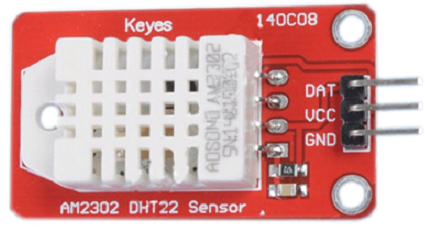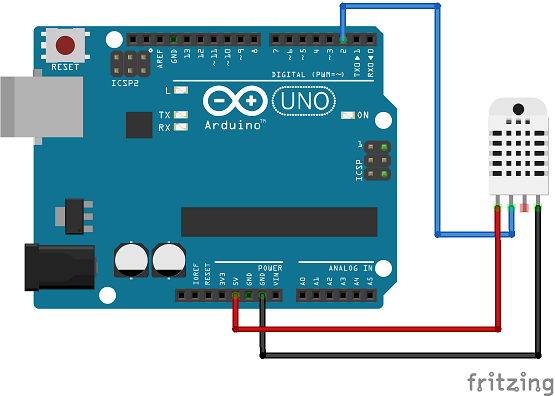This is an Arduino library for the calibrated AM2302/AM2303 digital temperature and relative humidity sensor on a DHT22 breakout PCB.
- Read 16-bit temperature (synchronous blocking)
- Read 16-bit relative humidity (synchronous blocking)
- Voltage: 3.3 .. 5V
- Ultra-low power:
- Typical 15uA dormancy
- Typical 500uA measuring
- Single wire digital serial interface
- Calibrated digital signal
- Outstanding long term stability
- No additional electronic components needed
- Humidity:
- Range: 0 .. 99.9 %RH (Relative Humidity)
- Resolution: 0.1 %RH
- Accuracy: +/-2 %RH (at 25 degree Celsius)
- Temperature:
- Range: -40 .. +125 degree Celsius
- Resolution: 0.1 degree Celsius
- Accuracy: +/- 0.4 degree Celsius
- Minimum read interval: 2000 ms
- ~31ms to synchronous read humidity, temperature and parity data from sensor (5 Bytes)
According to the datasheet, the AM2302/AM2303 is a low cost consumer temperature sensor. It may not be used in safety critical applications, emergency stop devices or any other occasion that failure of AM2302/AM2303 may cause personal injury.
Pull-up resistor DAT pin
- Connect an external
3k3..10kpull-up resistor between theDATandVCCpins only when:- Using a AM2302/AM2303 sensor without a DT22 breakout PCB and the MCU IO pin has no built-in or external pull-up resistor.
- The DHT22 breakout PCB contains a
3k3pull-up resistor betweenDATandVCC. - Please refer to the MCU datasheet or board schematic for more information about IO pin pull-up resistors.
External capacitor
- Tip: Connect a
100nFcapacitor between the sensor pinsVCCandGNDwhen read errors occurs. This may stabilize the power supply.
Connection DHT22 - Arduino
| DHT22 | Arduino UNO / Nano / Pro Mini / Leonardo / Mega2560 |
|---|---|
| GND | GND |
| VCC | 5V (or 3.3V) |
| DAT | 2 (DIGITAL pin) |
Connection DHT22 - ESP8266
Some ESP8266 boards uses Arduino pin 2 -> GPIO4 which is D4 text on the board. Make sure you're using the right pin.
| DHT22 | ESP8266 / WeMos D1 R2 / ESP12E / NodeMCU |
|---|---|
| GND | GND |
| VCC | 3.3V |
| DAT | D2 |
Connection DHT22 - WeMos LOLIN32
WeMos LOLIN32 requires an additional 100nF capacitor over the GND - VCC pins to prevent parity errors.
Use pin 0 to prevent flash problems.
| DHT22 | WeMos Lolin32 |
|---|---|
| GND | GND |
| VCC | 3.3V |
| DAT | 0 |
Other MCU's may work, but are not tested.
Arduino IDE | Examples | Erriez DHT22 Temperature & Humidity:
Initialization
#include <ErriezDHT22.h>
// Connect DTH22 DAT pin to Arduino board
// Arduino DIGITAL pin
#define DHT22_PIN 2
// Some ESP8266 boards uses D2 instead of 2
// #define DHT22_PIN D2
// LOLIN32 uses another pin
// #define DHT22_PIN 0
DHT22 sensor = DHT22(DHT22_PIN);
void setup()
{
// Initialize serial port
Serial.begin(115200);
Serial.println(F("DHT22 temperature and humidity sensor example\n"));
// Initialize sensor
sensor.begin();
}Read temperature and humidity
void loop()
{
// Check minimum interval of 2000 ms between sensor reads
if (sensor.available()) {
// Read temperature from sensor
int16_t temperature = sensor.readTemperature();
// Read humidity from sensor
int16_t humidity = sensor.readHumidity();
if (temperature == ~0) {
// Print error (Check hardware connection)
Serial.print(F("Temperature: Error"));
} else {
// Print temperature
Serial.print(F("Temperature: "));
Serial.print(temperature / 10);
Serial.print(F("."));
Serial.print(temperature % 10);
Serial.println(F(" *C"));
}
if (humidity == ~0) {
// Print error (Check hardware connection)
Serial.print(F("Humidity: Error"));
} else {
// Print humidity
Serial.print(F("Humidity: "));
Serial.print(humidity / 10);
Serial.print(F("."));
Serial.print(humidity % 10);
Serial.println(F(" %"));
}
Serial.println();
}
}Serial output
DHT22 temperature and humidity sensor example
Temperature: 17.7 *C
Humidity: 41.0 %
Temperature: 17.8 *C
Humidity: 41.1 %
...
- None
Please refer to the Wiki page.

